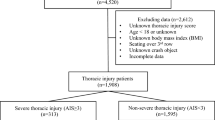Abstract
Purpose
Seatbelts and airbags are the most important devices protecting drivers from cervical spine injury (CSI) following motor vehicle collisions (MVCs). However, there have been few reports on the radiographic characteristics of CSI sustained by restrained, airbag-deployed drivers.
Methods
A single-center, retrospective observational study was conducted using prospectively acquired data. Between January 2011 and December 2017, 564 restrained drivers, whose vehicle had been severely damaged in MVCs, underwent whole-body computed tomography for evaluation of bodily injuries. The drivers were dichotomized into airbag (+) group (n = 218) and airbag (−) group (n = 139), after excluding 207 drivers in whom airbag deployment status was unknown.
Results
Eight and nine drivers sustained CSIs in the airbag (+) and airbag (−) group, respectively. The frequency of CSI did not differ significantly between the two groups (3.7% vs. 6.5%, p = 0.31). All eight CSIs in the airbag (+) group were classified as hyperextension injuries, and four of them sustained concomitant spinal cord injuries caused by dislocation. Within the airbag (+) group, the drivers with CSIs were significantly older than those without CSIs (65.2 ± 18.5 vs. 44.8 ± 18.7 years, p = 0.002).
Conclusion
Although it is without doubt that the combination of seatbelt and airbag reduces the frequency and severity of CSIs following MVCs, the CSIs sustained in restrained, airbag (+) drivers may not always be mild, and elderly drivers may be at an elevated risk of CSI. In addition, the possibility of a causal role of airbags in CSI requires consideration in this population.





Similar content being viewed by others
References
Wang MC, Pintar F, Yoganandan N, Maiman DJ (2009) The continued burden of spine fractures after motor vehicle crashes. J Neurosurg Spine 10:86–92
Stein DM, Kufera JA, Ho SM, Ryb GE, Dischinger PC, O’Connor JV et al (2011) Occupant and crash characteristics for case occupants with cervical spine injuries sustained in motor vehicle collisions. J Trauma 70:299–309
Smith JA, Siegel JH, Siddiqi SQ (2005) Spine and spinal cord injury in motor vehicle crashes: a function of change in velocity and energy dissipation on impact with respect to the direction of crash. J Trauma 59:117–131
Claytor B, MacLennan PA, McGwin G Jr, Rue LW 3rd, Kirkpatrick JS (2004) Cervical spine injury and restraint system use in motor vehicle collisions. Spine 29:386–389
Reed MA, Naftel RP, Carter S, MacLennan PA, McGwin G Jr, Rue LW 3rd (2006) Motor vehicle restraint system use and risk of spine injury. Traffic Inj Prev 7:256–263
Tator CH (2009) Spine fractures in motor vehicle crashes are preventable by the combination of seat belts and air bags. J Neurosurg Spine 10:83–85
Abu-Zidan FM, Eid HO (2015) Factors affecting injury severity of vehicle occupants following road traffic collisions. Injury 46:136–141
Davies RM, Scrimshire AB, Sweetman L, Anderton MJ, Holt EM (2016) A decision tool for whole-body CT in major trauma that safely reduces unnecessary scanning and associated radiation risks: an initial exploratory analysis. Injury 47:43–49
Price SJ, Suttner N, Aspoas AR (2003) Have ATLS and national transfer guidelines improved the quality of resuscitation and transfer of head-injured patients? A prospective survey from a regional neurosurgical unit. Injury 34:834–838
Inamasu J, Nakatsukasa M, Tomiyasu K, Mayanagi K, Nishimoto M, Oshima T, Yoshii M, Miyatake S, Imai A (2018) Stroke while driving: frequency and association with automobile accidents. Int J Stroke 13:301–307
Road Traffic Act of Japan, Article 3. http://www.japaneselawtranslation.go.jp/law/detail/?id=2962&vm=04&re=02. Accessed Aug. 31, 2018
Cleveland N, Colwell C, Douglass E, Hopkins E, Haukoos JS (2014) Motor vehicle crash severity estimations by physicians and prehospital personnel. Prehosp Emerg Care 18:402–407
Harris JH Jr (1978) Acute injuries of the spine. Semin Roentgenol 13:53–68
Vaccaro AR, Koerner JD, Radcliff KE, Oner FC, Reinhold M, Schnake KJ, Kandziora F, Fehlings MG, Dvorak MF, Aarabi B, Rajasekaran S, Schroeder GD, Kepler CK, Vialle LR (2016) AOSpine subaxial cervical spine injury classification system. Eur Spine J 25:2173–2184
Coleman WP, Geisler FH (2004) Injury severity as primary predictor of outcome in acute spinal cord injury: retrospective results from a large multicenter clinical trial. Spine J 4:373–378
Inamasu J, Guiot BH (2009) Thoracolumbar junction injuries after rollover crashes: difference between belted and unbelted front seat occupants. Eur Spine J 18:1464–1468
Traynelis VC, Gold M (1993) Cervical spine injury in an air-bag-equipped vehicle. J Spinal Disord 6:60–61
Okamoto K, Takemoto M, Okada Y (2002) Airbag-mediated craniocervical injury in a child restrained with safety device. J Trauma 52:587–590
Batra S, Kumar S (2008) Airbag-induced fatal subaxial cervical spinal cord injury in a low-velocity collision. Eur J Emerg Med 15:52–55
Hart RA, Mayberry JC, Herzberg AM (2000) Acute cervical spinal cord injury secondary to air bag deployment without proper use of lap or shoulder harnesses. J Spinal Disord 13:36–38
Blacksin MF (1993) Patterns of fracture after air bag deployment. J Trauma 35:840–843
Segui-Gomez M, Levy J, Graham JD (1998) Airbag safety and the distance of the driver from the steering wheel. N Engl J Med 339:132–133
Author information
Authors and Affiliations
Corresponding author
Ethics declarations
Funding
No funding was received for this study.
Conflict of interest
The authors declare that they have no conflict of interest.
Ethical approval
All procedures performed in the studies involving human participants were in accordance with the ethical standards of the institutional and/or national research committee and with the 1964 Helsinki Declaration and its later amendments or comparable ethical standards. For this type of study formal consent is not required.
Informed consent
For this type of retrospective study formal consent is not required.
Rights and permissions
About this article
Cite this article
Inamasu, J., Kato, M. Airbag deployment and cervical spine injury in restrained drivers following motor vehicle collisions. Neuroradiology 60, 1307–1313 (2018). https://doi.org/10.1007/s00234-018-2114-1
Received:
Accepted:
Published:
Issue Date:
DOI: https://doi.org/10.1007/s00234-018-2114-1




